Nothing can compare to ranunculus and anemones for spring sales, especially if you are in the wedding business! These Mediterranean natives prefer a temperate climate, one that stays cool but doesn’t get terribly hot or cold. Yeah, me too. But, alas, that’s not our climate here in Philadelphia where the winters are bitter and the summers sweltering.
When I first got into flower farming, I immediately ordered myself a couple hundred corms (the proper term for the “bulb” that produces ranunculus and anemones) and thought I’d just pop them in bulb crates in my basement in February to start and then set them outside when the spring weather warmed. That plan was a total flop. The plants were sickly, and the blooms stunted and deformed.
Anemones and ranunculus like a very long, cool establishment period to develop a robust root system and lots of foliage to support an explosion of blooms in the few months of cool spring weather around here. After several seasons of growing these beauties in zone 6b and 7, in my opinion, only those planted in the ground in the autumn and protected through the winter really produce enough high-quality blooms to make them a profitable crop. We typically have anemones starting to bloom in our hoop house in late January, and ranunculus coming along a little later when the daylight hours lengthen, usually in late February. Steady production for sales runs from March to May. This year’s been a bit different thanks to the intensity of the winter cold, but this hopefully isn’t the norm. Hopefully.
A hoop house is very handy to have when growing anemones and ranunculus. But even if you don’t have a hoop house, you can still produce a lovely crop of these flowers with some carefully engineered low tunnels (or “caterpillars”) out in the field. The low tunnel concept was originally popularized by Eliot Coleman for winter veggies, but low tunnels work just as well for flowers. It took a couple (frustrating) years to figure out how to build these to withstand fierce wind and heavy snow. We finally have the formula down and our low tunnels can take just about anything.
We build these inexpensive structures with half-inch metal electrical conduit from Lowes, a hoop bender, greenhouse plastic, tomato twine, and Agribon fabric. If you’re a subscriber to Growing for Market, there was an article a few issues back about how Tony at Bare Mountain Flowers builds his. Tony is a wiz at building and inventing. We based our design off his and then tweaked it with metal hoops and a few other adjustments to withstand our heavy snows. We’ll be demonstrating how to build low tunnels at some of our workshops this spring.
A great rule of thumb for any crop is to think about ordering for next year when the current season’s crop is finishing up. Therefore, anemones and ranunculus corms should be ordered in early summer. My favorite supplier is Gloeckner. They are a large wholesale supplier with high minimums. If you want to try a small batch first before committing to a big crop, a quick online search will yield several retail suppliers for ordering smaller quantities.
For ranunculus, I’m especially fond of the Le Belle series for our climate here. We’ve also been trialing the Amandine series in smaller quantities over the past two seasons. This series has been bred to withstand a bit more heat before going into dormancy in May or June. However, it seems this breeding has made it harder for Amandine to grow as well through the cold of the winter months so the plants are weaker than the Le Belles overall. Therefore there’s been no increase in production by having a longer harvest window. Amandine does seem to be coming up with some unique colors though so we’ll keep trying them.
For anemones, we’ve had great success with the Galilee series. This series has the ever-popular white face with the black eye, sometimes called the panda anemone. The plants are super productive, amazingly tough, and the stem length is outstanding at 18 inches plus. We’ve also grown the Jerusalem series in the past but have since switched to Galilee entirely as the plants are just so tough and productive.
Planting of both anemones and ranunculus ideally takes place in the first half of October but can happen as late as mid-November for abundant spring blooms in our region. We soak and pre-sprout the corms per the directions sent by Gloeckner with the order.
If you’ve been following along here on the blog, you already know we’ve gone through several intense “polar vortex” spells this winter, making it one of the coldest and snowiest on record. The temperatures routinely dipped to the single digits and the wind chills were often well below zero. There were many days too when the sky was cloudy, greatly limiting the available light and solar gain inside the structures. I was fearful that the ranunculus and anemones wouldn’t survive these harsh frigid conditions (and that the low tunnels would collapse under the weight of the snow, but they didn’t). I’m here to say, these babies are TOUGH! In fact, I’m expecting a bumper crop this spring.
Both the plants in the hoop house and the low tunnels have been kept under a double layer of Agribon fabric during the coldest stretches of the winter. The fabric is taken off on warmer days so the plants can get the maximum light. Watering and fertilizing with a cocktail of fish emulsion, kelp, and compost tea has been limited to when temperatures were going to be above 25F at night for at least three days (that’s only happened twice all winter!) so growth has been a bit limited by the lack of water and nutrients. Ideally both crops should be watered deeply and fertilized once a week when they’re actively growing. These crops love to soak up water and nutrients. Anemones in particular love a deep drink.
Weed management is a crucial key to a highly productive crop. If it’s warm enough in the tunnels and hoop house for the ranunculus and anemones to grow, it’s warm enough for the weeds. Weeding in the hoop house is not that hard and actually kind of nice on a winter day when it’s warm inside and cold outside.
But weeding the low tunnels is really tricky since you have to kneel on the ground in the snow or mud. We’d struggled to keep up with the weeds until this season, when we’ve started using a new product called FloraFlow, which is black plastic with pre-punched holes that are perfectly spaced and sized for growing ranunculus and anemones. This weed barrier has been superb at suppressing weeds and no doubt key to it looking like one of the best crops to date in the low tunnels. I think the black plastic has also kept the soil warmer through the cold snaps. That’s great in the winter but a problem once it gets hot outside so we’ll be covering the plastic with straw as things heat up.
For growers who have not tried either of these crops yet, I would highly recommend starting out with just anemones. They are able to withstand cold better than ranunculus, and they have a longer bloom window than ranunculus, making it easier to get a profitable number of stems while you fine-tune the mechanisms for keeping them happy in our cold winters. Once you’ve tried your hand at anemones and feel confident, add ranunculus.
Both crops fizzle out when the temperatures get in the 70s. Usually plants are done producing by mid-May. If we’re lucky, we can eek out a couple dozen stems for weddings until the first weekend of June. I really love it when the peonies and ranunculus overlap. Pure designer bliss!

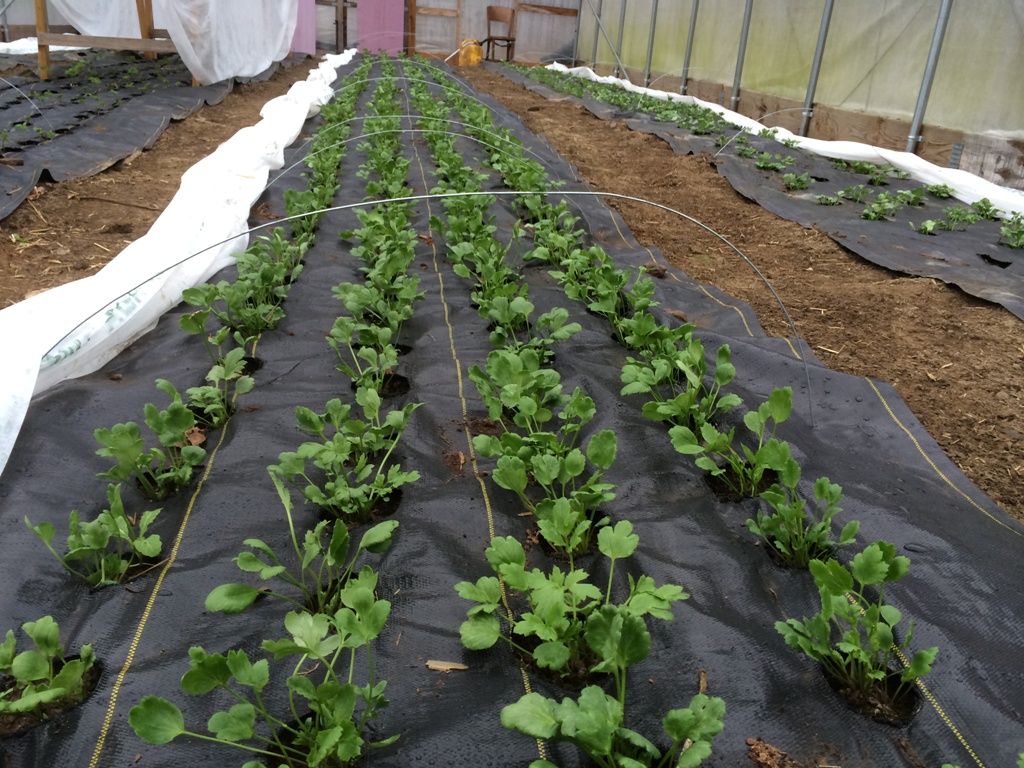
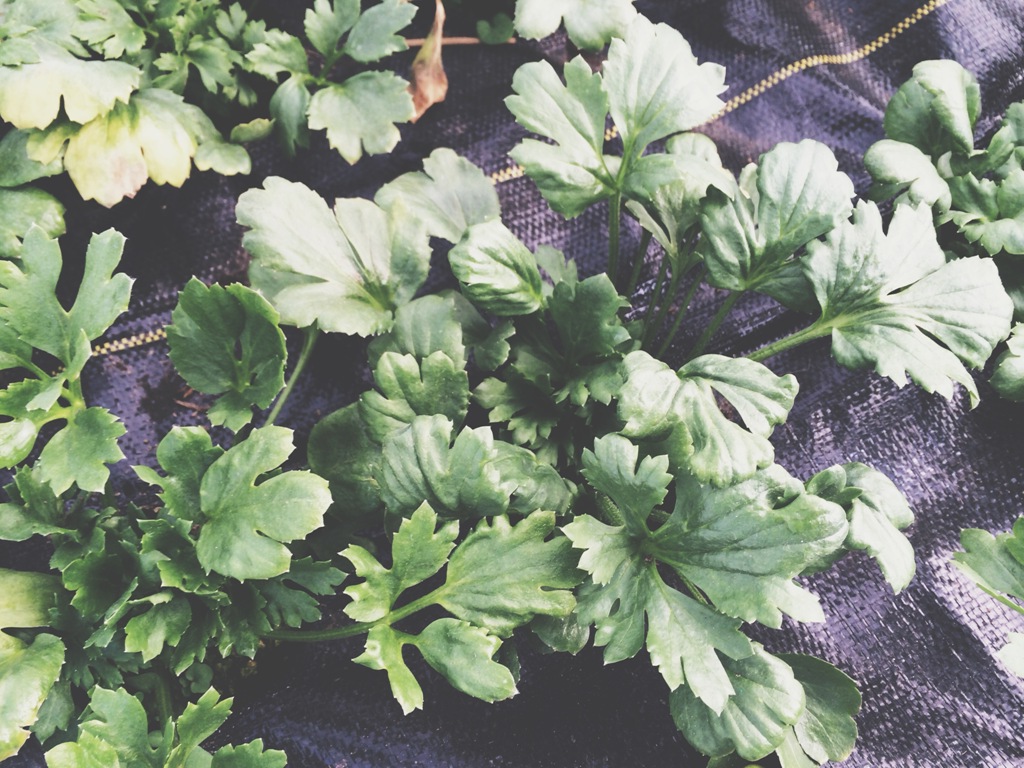
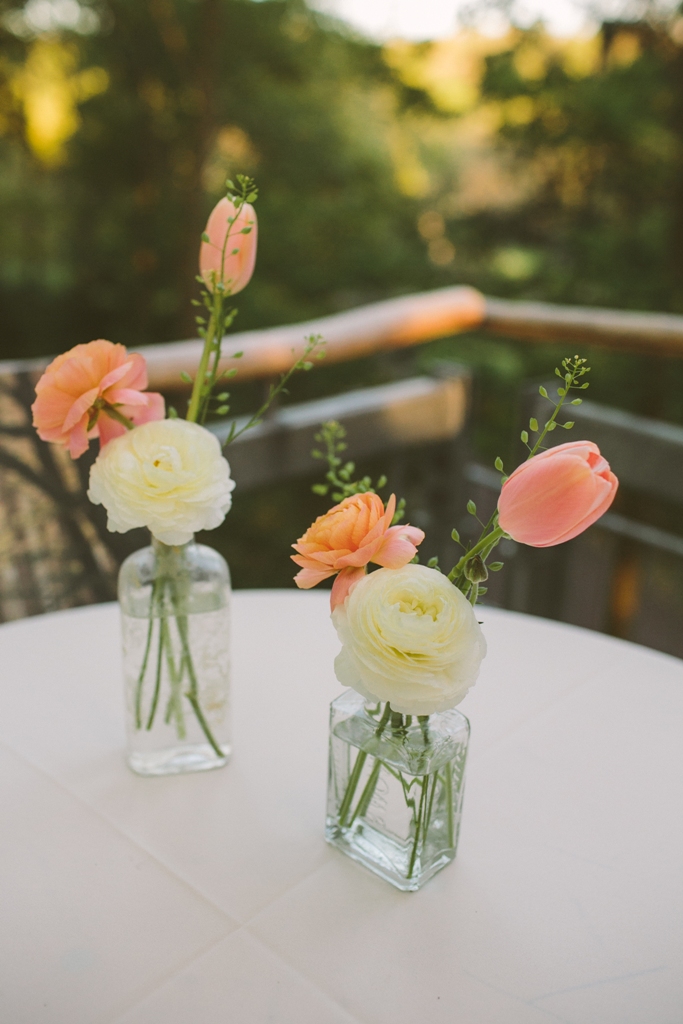
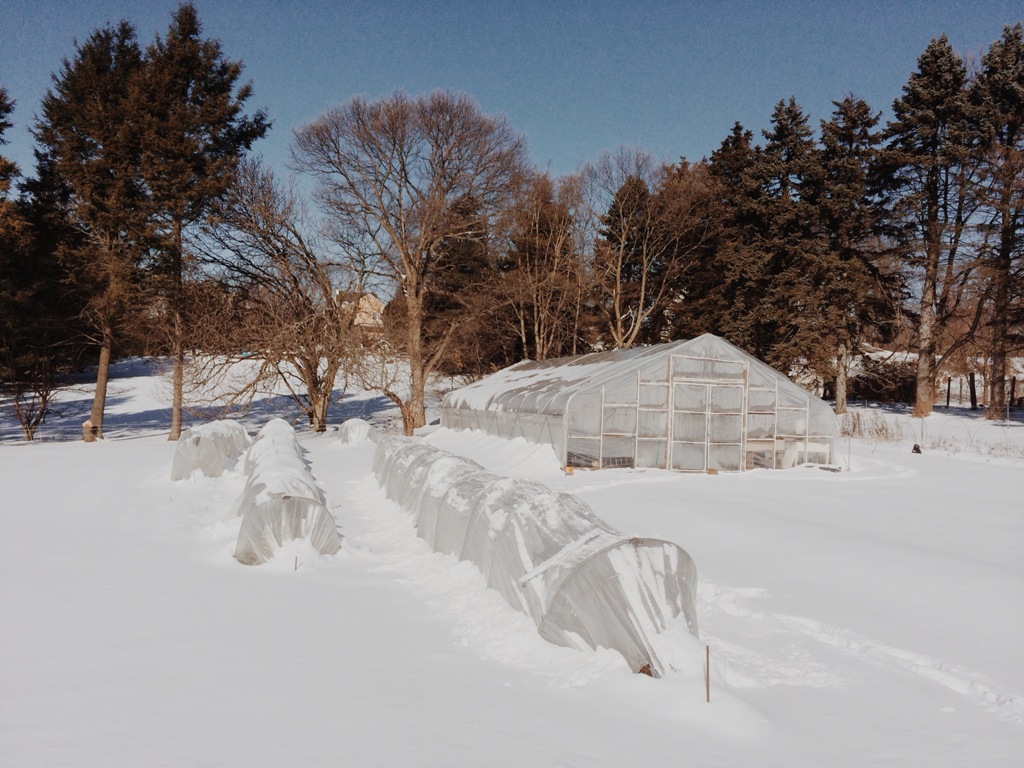
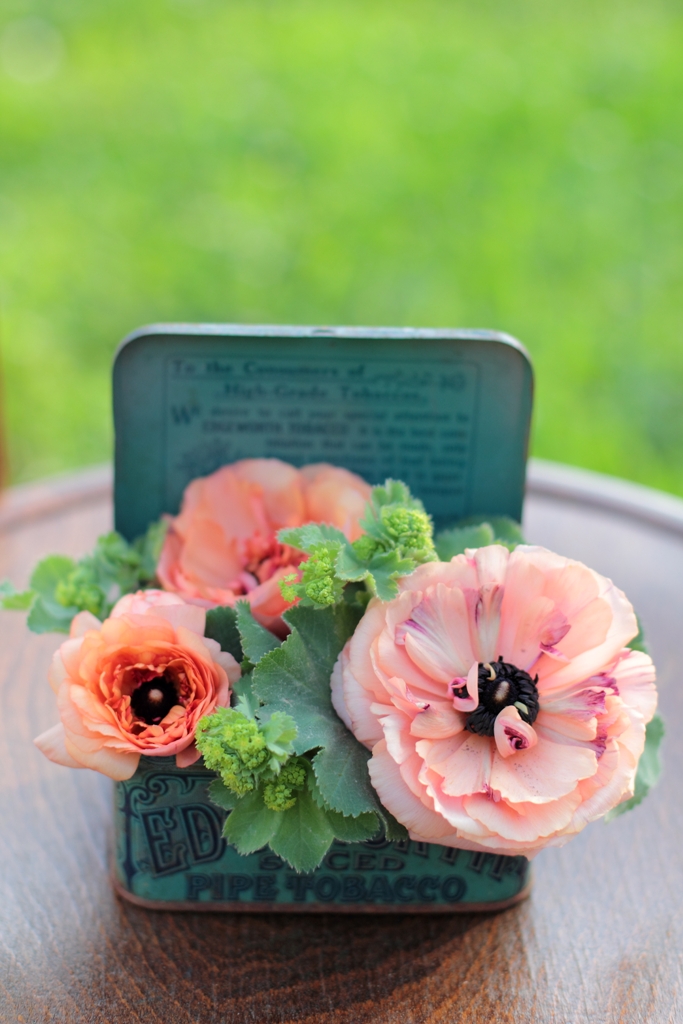
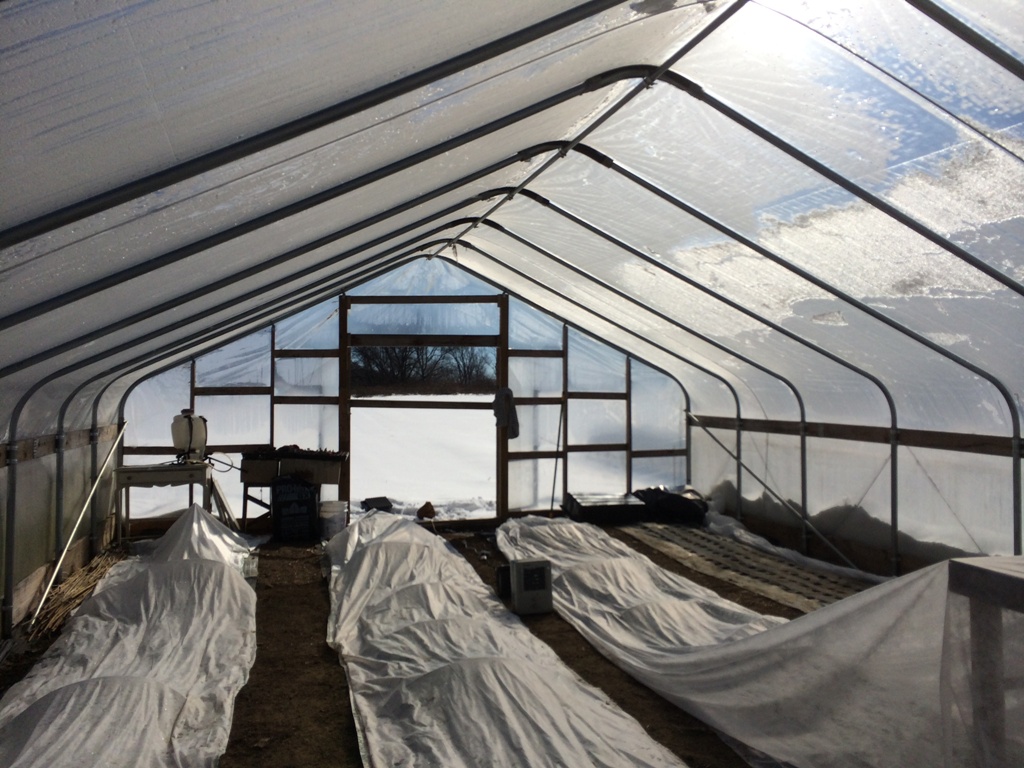
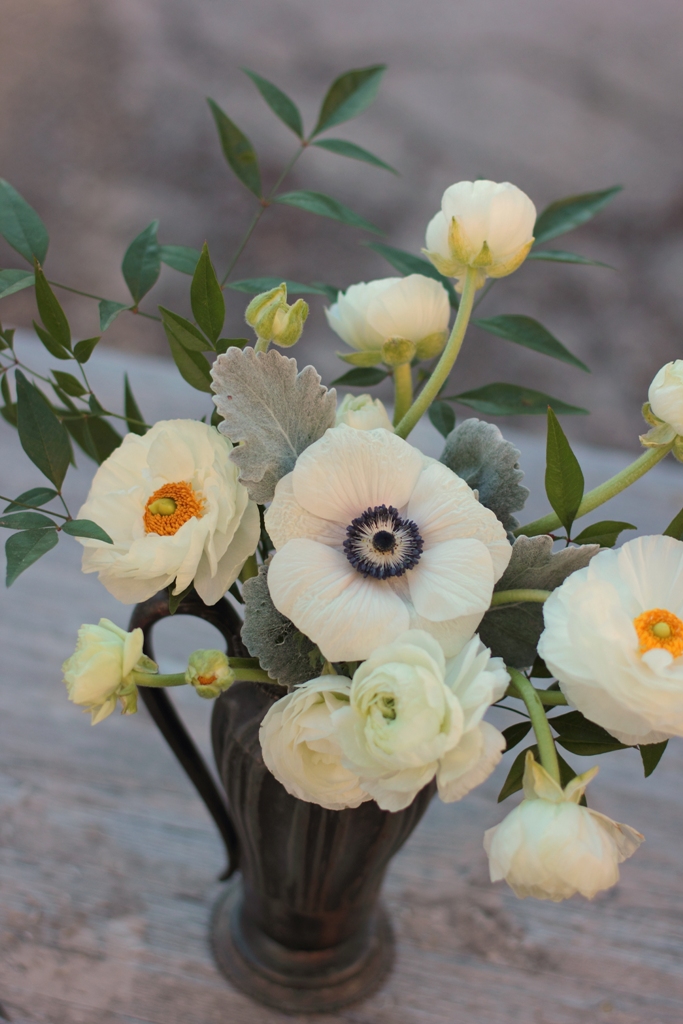
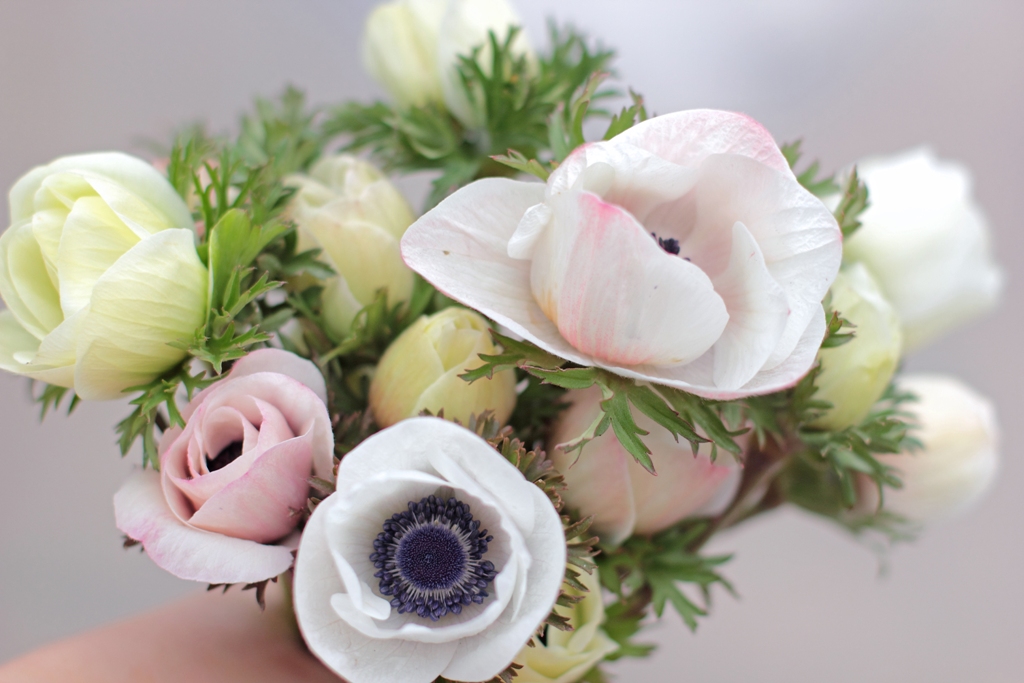
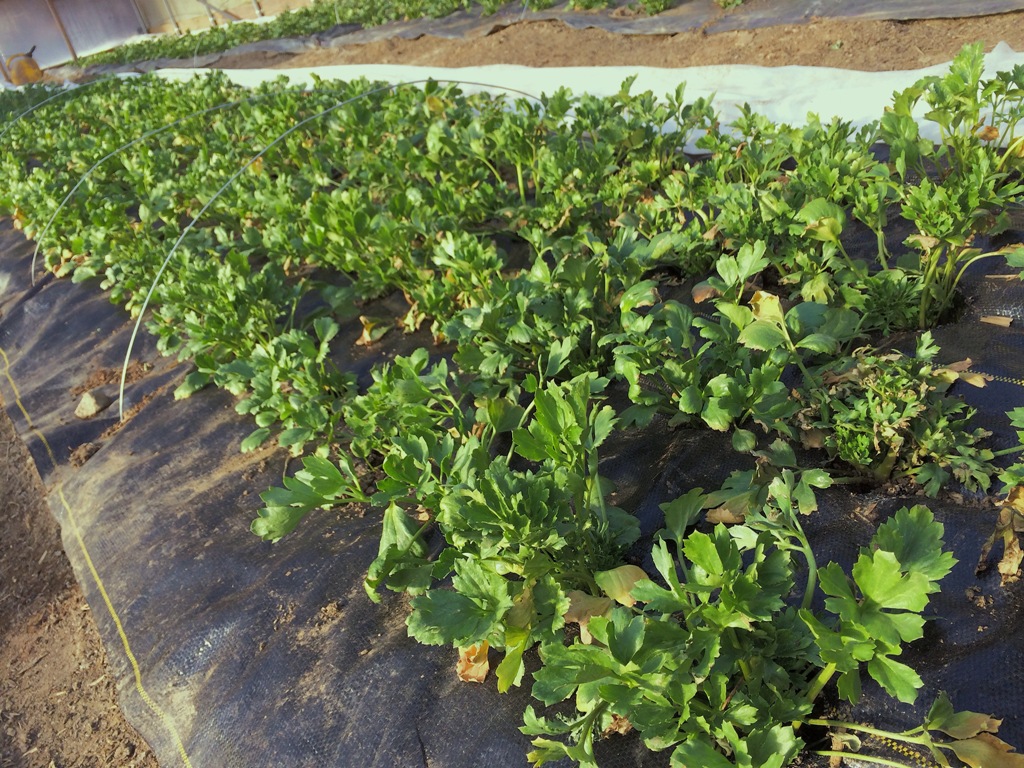
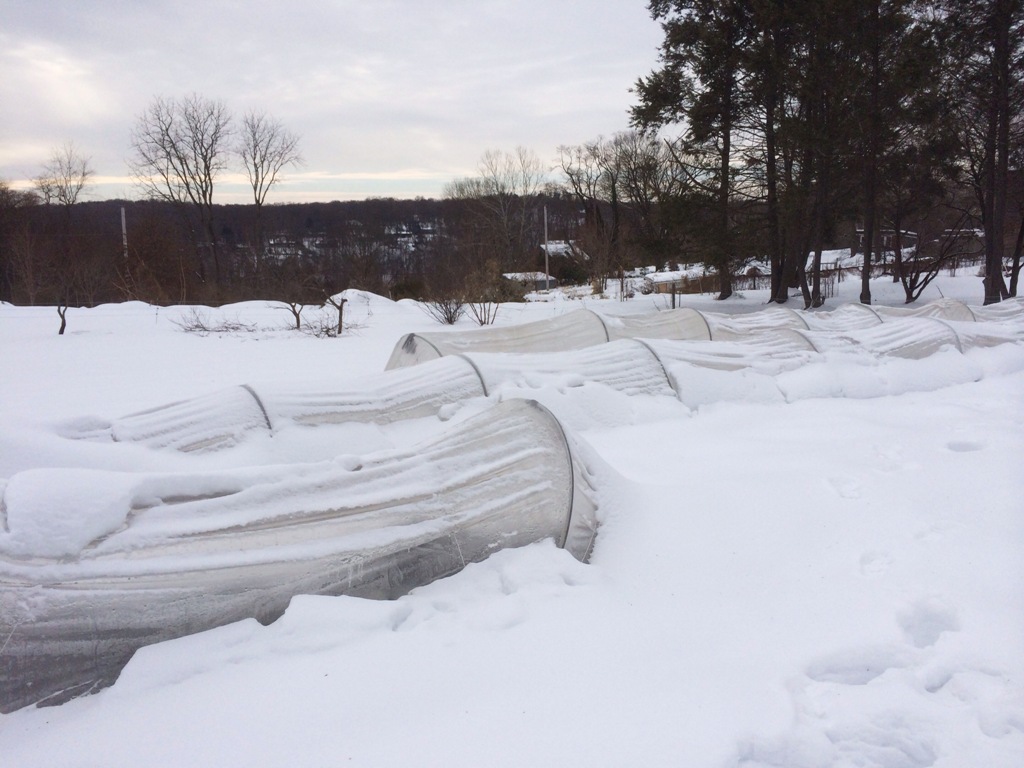
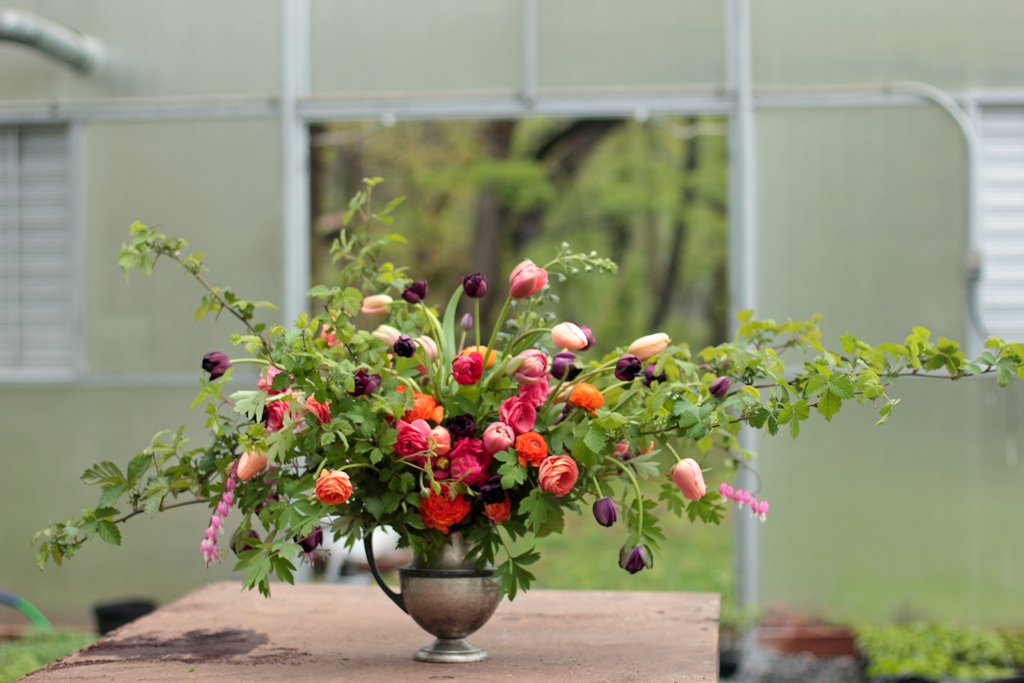
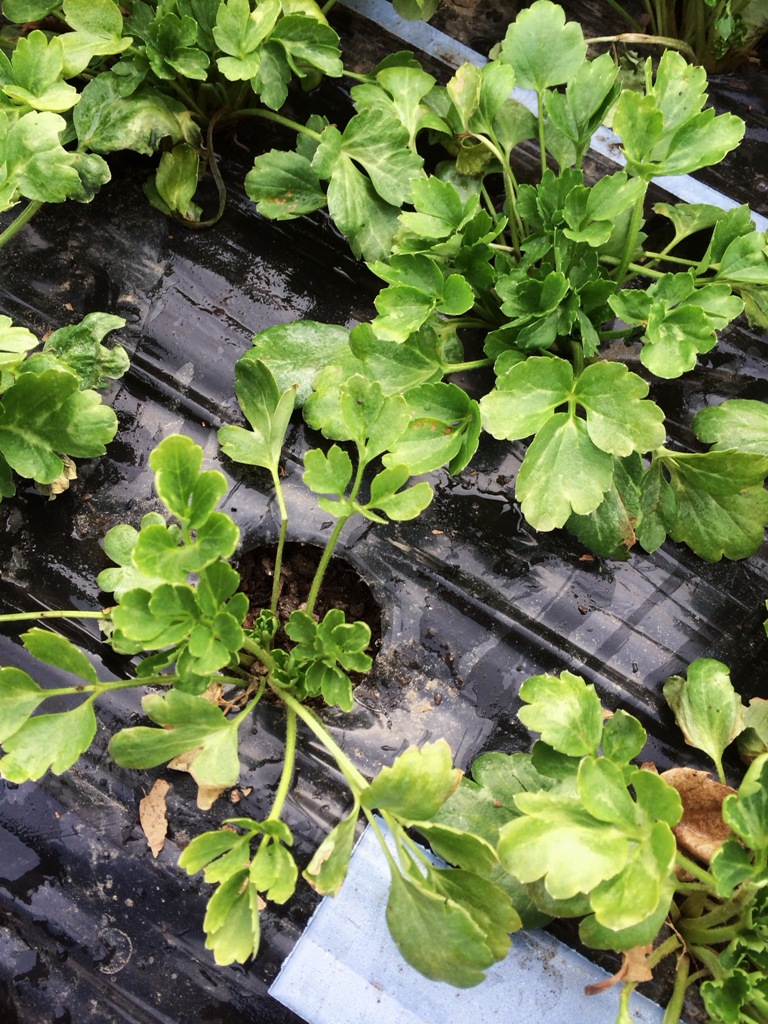
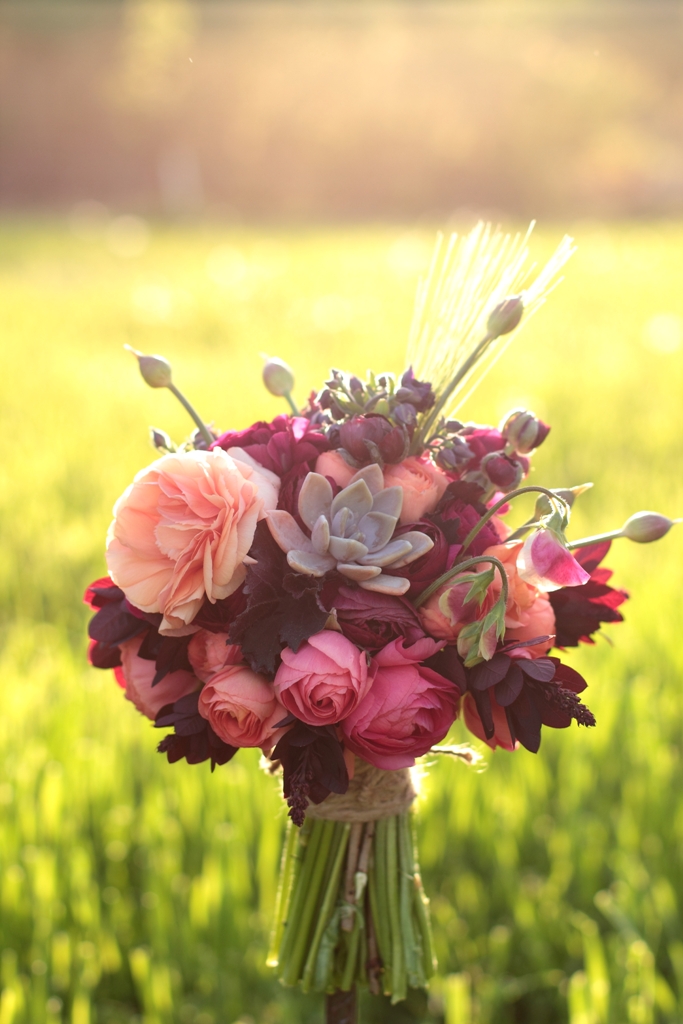
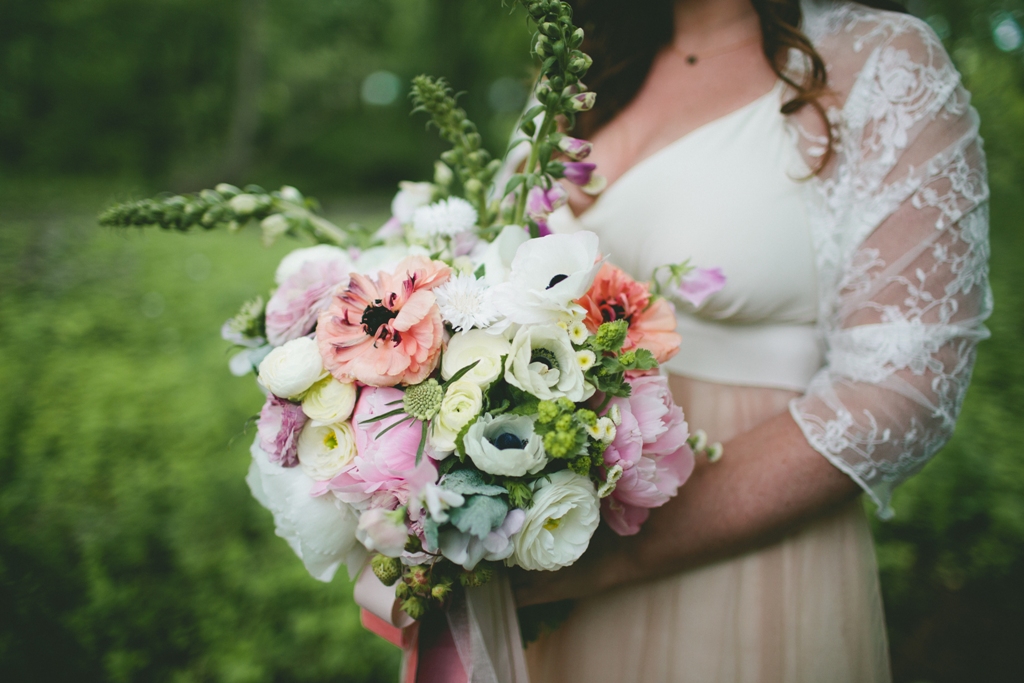
Hi Jenny,
Have been following you via facebook and your blog a long time. As a veteran grower & ASCFG member I get a regular boost from your energy and enthusiasm.
I will be speaking at the Seattle Wholesale Grower’s Conference on March 8th. Part of my talk will include sources for products and ideas. I hope you don’t mind my mentioning your blog.
MaryLee Johnson/Windswept Acres/ Cecil, WI
thank you for the great tutorial. your plants look roaring to go for this spring,so healthy.
Great blog, thanks for all the terrific information. These are next on my list of plants to attempt. We are in western Maine so it will be a real challenge.
Congrats again! 🙂 Flori
Just read your blog about anemones and ranunculus . I just planted my 1000 ranunculus today which is feb. 28. Crazy huh? They have been in a pre-planting mode since I got them from Tom at gloeckner about 3 weeks ago.had some long roots. This is all an experiment I shall say. We have two hoop houses but they are taken up with nursery stock and machinery through the winter. If it weren’t for the snow of 11″ last week they would have been in earlier. I felt lucky to get them in today, too much snow .relieved really! Interesting that anemones are easier and hardier. Must try them!
I tried anemones and ranunculus under low tunnels, but it looks like a failure so far.
In late October I planted 250 anemones and 100 ranunculus from Gloeckner. I pre-soaked, dipped in Oxidate bactericide, covered low hoops with greenhouse film. Because the winter was so harsh (we’re in West Chester, PA) we covered the beds with a thick layer of straw. I’ve got one anemone that’s about 1/2 inch high. Nothing else. Today I removed the straw. Time to give up hope? Or is it possible that with the straw off, they’ll get some sunshine and wake up. Any advice is much appreciated.
Hmmmm…. did they not sprout in the fall before it got cold? They should have. If not, then something was likely wrong from the start. When you pre-soaked them, did you leave the water trickling so there was oxygen still available to the corms? How long did you soak them for? Anemones need 24 hours but ranunculus should only be soaked for 4-6 hours. Also, funny question but a rookie mistake I made my first year, did you plant them the right end up? Ranunculus should face their little claw down. Anemones are not as fussy. The thick straw may have kept them from sprouting earlier so don’t give up hope quite yet. There’s nothing to be planted in their place now anyway so give them another week or so to see if growth emerges. We’re hitting prime anemone and ranunculus growing conditions here (finally) and if they’re going to make a go of it, they’re going to do it soon. 🙂
Thanks for responding. None of the corms were sprouting when I planted them. I did soak them for the correct # of hours. I put a little aquarium pump in the water that was blowing bubbles the entire time. I was careful to plant them the right way (I hope). With such a wicked winter, I’m afraid they may all be dead. Yesterday, I watered and fed wih kelp meal and fish emulsion. Fingers crossed that the warmer weather and no straw blanket over them that I’ll start to see some growth.
I popped over after a mention on Erin’s blog about this series. Thanks for the great information. I am off to look at more posts.
A couple questions — thinking about giving these a try next year under a low tunnel. I’m really glad you mentioned using the low tunnel because I don’t have a hoop house and I feel like that has limited a lot of my options. I would love any information about using a low tunnel compared to a hoop house. Do you use just the plain greenhouse film plastic or a punched hole or slitted row cover plastic? I already have the slitted plastic (have snaps growing under that now) but I’m thinking that probably wouldn’t make it all winter. Does the Flora Flow fabric just make it easier? Is there any reason regular black plastic & a soaker hose wouldn’t work? Hopefully my last question doesn’t make me seem too lazy but its such a pain in the butt to remove the plastic from the tunnel (and then put it back on)to get in there to fertilize or harvest– do you have any tricks to make that easier? Thank you for the inspiration!
Regular greenhouse plastic, Sarah. Yes, the FloraFlow makes it much easier and the holes are the perfect size for the plants to grow up but not weeds. You could use regular black plastic and drip tape. There’s no easy way around fertilizing and harvesting under the low tunnels. It’s tough. You can tie the plastic up at the top of the hoops instead of taking it the whole way off. Hope that helps!
Do you lift the corms at the end of the season or leave them in the ground? I do have a poly tunnel. I understand the corms multiply very quickly but didn’t know what to do with them after flowering?
Vikki –
We discard the corms after they blooms each season and buy new for the next year. We are a small farm that needs the bed space for other crops as soon as the ranunculus are done blooming so we can’t save them over. Wish we could!
Would it be possible to leave the corms, plant cut lettuces or other shallow root herb for the remainder of the season, Chop & Drop it in Oct. (mulch etc.), and check for sprouts in Nov. …? I ask only because I just heard you explain how you leave Dalia tubers in-ground overwinter ;D
On average, how many stems of ranunculus do each of your corms produce? This was my second year growing them– wildly more successful than the first–but they literally pushed up about 10 stems each and were done all in the span of 2 weeks. I am in Austin TX, so it heats up pretty quick once Spring hits. I was wondering if I could extend the bloom time by planting another round 2 weeks later than the first in the Fall? Would love to know your thoughts. Thanks!!
What a divine site. I have tried for 2 years to grow ranunculous . No luck
None of the nurseries sell plants. I am so interested in buying the plants and seeing if I could winter them over.
Any suggestions
thanks
Rosemarie
Hi Jennie – We met at your Flower Farmer two-day seminar. I have a question: Do all Anemone require planting in Winter with a low tunnel etc? I’ve found some Anemone hybrida from Pioneer Gardens (such as Anemone hyb. ‘Honorine Jobert’) that actually bloom in Aug/Sept. I’m assuming these are different – yes? I’d love to have anemone, but no tunnel and brutal winds in the winter. Just not something I can take on at the moment. Thank you~
Hi Karen! You are right — Anemone hybrida is a different species that is a perennial and blooms in the fall. It’s usually called Autumn Anemone or Japanese Anemone to distinguish it from the spring blooming anemone. It’s sure to grown nicely in your area. It like shade though so hopefully you’ve got some of that. It’s not really a substitute for the more showy spring anemones, but it’s really one of my favorite fall blooms due to it’s delicate buds that look amazing in floral arrangements! You should absolutely give it a try!
Hi Jennie
I have a couple of raised beds (about 8″ high) which have sleeves to accept hoops and a plastic cover. Do you think ranuncs would have a chance if I planted and covered them in the raised bed? Or do you think the soil would get too cold being slightly above actual ground level. I am in Virginia in zone 7a. Thanks so much for the post. So informative!
Jenn
Thank you for writing this up, I hadn’t thought it would be possible to overwinter them here. I’m northeast of Philly. I was wondering how warm it gets in the low tunnels on sunny days and do you ever need to vent them to prevent overheating? And do you think it would be possible to do in a raised bed, say, 18″ high?
Thanks again!
Laura
Hello Jennie!
Your post brings so much hope to me as I venture in to flower farming! =) I just ordered a few ranunculus from an online bulb co and anticipated delivery in October, however they are shipping now in June. : / Do you have any idea if they can be forced for a fall crop under frost protection, or shall I just wait until October and plant for next spring?
Also, do you know of an acceptable organic fungicide to use?
Thanks so much in advance!
~Dani
Thank you for sharing this valuable information! I see that you lift and discard your corms. However, I was wondering if it is possible for them to be left in the ground or must they still be lifted and stored for a period of dormancy?
I don’t have a hoop house yet, but I do have a pretty tight little polycarbonate greenhouse. In Kentucky we can have some mild winter days along with the cold. Would it be too warm in a greenhouse for the ranunculus? I don’t need a large amount of flowers as I am approaching flower farming on a very small scale for now.
In reference to watering, you mention they only need to be watered if temperatures are about 25F for three days in a row. Is this soil temperature, outside temp or high tunnel temp? I’ll be growing Renunculs this year in a very cold climate but under a high tunnel that I will start in November. Very curious about watering.
Hi. First time I’ve planted some Ranunculus bulbs.(about 40 or so being my wife’s favorite flower) I planted them mostly in lager size containers. We are on Long Island NY. This week late November/1st days of Dec I noticed some greenery growing. Is this normal. Will it die off in the cold and the flowers will begin to bloom. Or will the greenery stay until flowers bloom?
Thank you for any help
Hi, Jennie, I am not a flower farmer but would like to be and live in southwestern Ohio growing zone 6a. I want to learn how to make a low tunnel to grow ranunculus. I live in a neighborhood that has restrictions on what is allowed in our yards, so I am hoping to make a low tunnel that is as inconspicuous as possible. What I need to know is how tall do the tunnels have to be to grow ranunculus. I understand that flowers can grow better/ taller inside of tunnels.
Thanks so much for your help.
Jennifer Johnson
Hamilton, OH
Hi Jenny,
Always love your blog info and your beautiful arrangements. Have been looking for the following info including on the ASCFG but can’t find it re ranunculus blooms. Mine are in full bloom inside low tunnels and the forecast is for temps down to the mid 20’s. I know my plants can tolerate these temps with layers of row cover, but I don’t know about the buds and open flowers. What do you think? Should I cut them or leave some? If I cut, what’s the best way to hold them for my Saturday market?
Thanks
Marcia
Thank you for taking the time to write your blog! The information is so helpful! I am a beginning cut flower grower in Virginia and would like to know if you are using single or double line Flora Flow mats for anemone and ranunculus?
If using pre-burned landscape fabric:
1) Do you use 9×9 spacing?
2) Do you plant pre-sprouted corms directly into holes and they find their way to the sun?
3) How many lines of drip irrigation and do you water during winter months or wait until temps warm up in Spring?
Thanks!
Have you tried to grow Carmel and Meron anemones in addition to the Gallelie?
They are all Israeli varieties and I’m not sure which one to order.
Thanks- Yuda
Can you recommend anemone suppliers for very small orders? I did do a google search but could only find one variety from Longfield Gardens.
I have a problem, I live in Virginia in zone 8 and planted anemone and ranunculus in November and they are so big they are pushing against the frost cloth and it is only the end of January, should I cut them back because they are definitely to big for this time of the year. I had frost cloth and greenhouse plastic over them, should I take the plastic off and leave it off.
Hi Becky –
You’ll want to get bigger hoops to support your fabric and plastic. Do not cut the plants back as you’ll be stealing valuable growth from them at a critical time in their development. But if you get bigger/taller hoops, that will keep the fabric and plastic off of them. Good luck!
Hi Jennie! Thanks so much for the effort you put into developing this helpful post! I’m also in Southeastern PA (Glenmoore, zone 6b) and was wondering what grade frost cloth you’d recommend for anemones and ranuculus? Agribon offers such a wide range – I’d love to know which grade you like to pair with your greenhouse film. Thanks so much!!
Hi Megan! We generally us Agribon 19 for inside low tunnels and hoop houses. If you’re only using the Agribon and not plastic for something (say a row of cool annuals), you may want to invest in a heavier weight as it does not rip as easily in winter winds.
Jenni, I am in Plymouth MA with the same zone of 6b. I just want to be certain I understand you correctly.. I should pre sprout my corms ASAP and plant them out ASAP. Then cover with a caterpillar tunnel even though the ground will freeze solid come January/Feb??? I only have 100 corms and can’t lose them like I did this year. yikes
thank you
Peggy Gino
Hi Peggy – Are you planting anemones or ranunculus? Anemones should be just fine for you up there to plant now. Ranunculus are a bit iffy, depending on exactly how cold you get and how windy it is in your garden.
I enjoyed reading your article. Although I am not a grower, I was interested in knowing if I could grow a couple of Ranunculus plants indoors this winter or if they need a cold period like tulips? I suppose I could make a little tunnel if necessary. I live in Rhode Island zone 6b. I do have a grow light.
Janet
Hi! in am enjoying all the comment. If I have pre-sprouted anemones can i put in a cold frame in Feb (zone 7) or should i start them under lights inside? How much sun do they need if i a cold frame outside. Will they sprout or just stay dormant until spring?
I live on the Jersey Shore. I purchased a ranunculus potted plant and it lasted a few short weeks. How do I store the corms and when can I plant them in a large pot.
Hi! I have a greenhouse made of plastic walls, and I am thinking of planting, or at least starting anemone and ranunculus in two raised metal garden beds. (I’m in zone 6a) Do you think this will work ok? Thanks for any help!
Hi Jenny! I’m wondering if you have ever been able to produce ranunculus or anemone in time for Valentine’s Day?
Do you think this would be possible with a heated greenhouse situation? Maybe in crates? We are in southern connecticut, a similar zone to you. We have sold them potted in april (with a feb start date). Never tried Autumn sprouting before. Many thanks!
I have not. I know some growers with heated greenhouses do but they usually have supplemental lighting as well as there just aren’t enough hours of daylight in February to produce quality blooms.
1 anemone corm has grown. 1 corm i do not know. why has 1 corm rotted? I have been taking them in every night. Should I leave ´them on my glazed balcony instead? It is 5-10 C at night there.All ranunculus corms have grown. I have been taking them in every night. Should i leave them on my glazed balcony instead where it is 5-10 C at night? Should I cover them with garden gauze cloth?